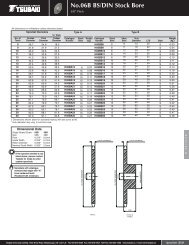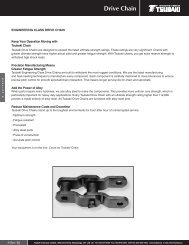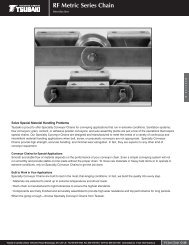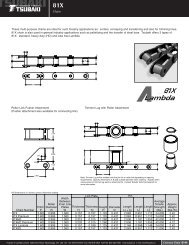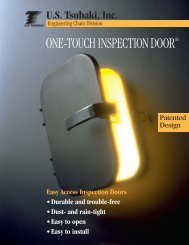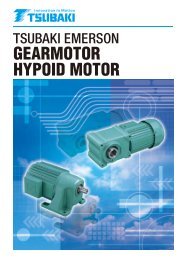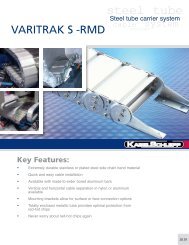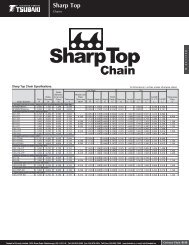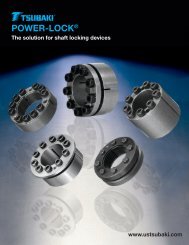Roller Chain - Tsubaki
Roller Chain - Tsubaki
Roller Chain - Tsubaki
Create successful ePaper yourself
Turn your PDF publications into a flip-book with our unique Google optimized e-Paper software.
<strong>Roller</strong> <strong>Chain</strong>Installation & MaintenanceDrive <strong>Chain</strong>6.2 Inspection IntervalsRegular inspection of roller chain is recommend at one-monthintervals. Inspection should be carried out at shorter intervals inthe following cases.1. Special or corrosive environments2. High speeds with sudden stoppage3. Lifting or indexing operations6.3 Inspection requirements for ordinary transmission1) Inspecting condition of lubrication1) While the chain is driving, check to see if there islubrication in the clearance between the outer link plateand inner link plate. Also check if the chain or rotating discis immersed in lubricating oil.2) When the chain is stationary, the chain surface willgenerally appear dirty from wear dust if lubrication isunsatisfactory. This is especially the case between the linkplates.3) When the chain is removed, connecting link pins and theedge of the inside of the bushings should be checked. Ifthere are any scratches, red or reddish-brown color,lubrication is improper or insufficient.2) Inspection of link plates1) If repeated loads over the maximum allowable load are puton the chain, there is a strong possibility of fatiguebreakage of the link plate. It is difficult to notice initialcracking from fatigue breakage simply from externalobservation.3) Inspection of pinsWhen the pins rotate, the roller chain must be completelyreplaced with new chain. This also applies to the connectingpins. By removing the connecting parts it is possible to see theconditions of wear and rust on the surfaces of the pins.Fig. 25 Rotation of the pins4) Inspection of the rollers1) As with the link plates, if rollers are also subjected to loadsover the maximum allowable load, the repeated impactload between the chain and the sprockets may causefatigue breakage to occur. The roller should be checked inthe same way as the link plate.2) If foreign objects interfere with the engagement of theroller and sprocket, the roller may be damaged and acrack may develop. Careful attention should be paid to theabove. In high-speed operations, even if foreign objectsdo not interfere with engagement, cracks may appear fromthe impact with the sprocket teeth.3) <strong>Chain</strong>s damaged from fatigue breakage of the rollers mustbe completely replaced, because each part has receivedthe same amount of repeated load.2) Usually, a crack develops at the edge of a hole or at theside of the link plate, as shown in the illustrations below.The presence of cracks should be checked carefully.Fatigue breakage progresses little by little, so it can benoticed if close attention is paid.HFig. 23 Cracks on the link platesH × 5%Example of a crackFig. 24 Wear on the edges of the link plates3) When wear occurs from sliding between the edges of theplates and the guides, it is necessary to adjust the positionof either the chain or the guides. The allowable wear onthe link plates is limited to 5% of their height.Fig. 26 Cracks on the rollers4) Also check if the roller rotation is poor.5) Inspection of the sprockets1) <strong>Chain</strong> and sprocket engagement can be checked byobserving the roller and surface of the teeth. Properengagement is when the contact area is uniform with pointA in the illustration (figure 27). If the contact area islopsided or the sides of the teeth are wearing away (pointB in figure 27), this may have been caused from improperinstallation of the sprockets or twisting of the roller chain.In this case, rechecking/readjustment is necessary.2) The normal point of impact is slightly up from the toothbottom. However, when initial tension is applied to thechain and tension remains on the slack side, the roller willslightly touch the tooth bottom. However, point A (figure27) receives the strongest impact.A-114



